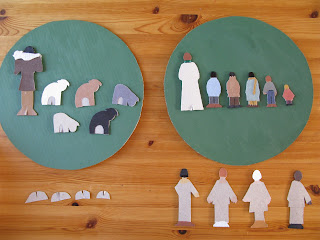It was months ago that I promised Sheila from Explore and Express that I'd write about how I made my World Communion materials. Since then she's gone ahead and made her own materials in her own way, which I'm glad about for her sake. But I'm perfectly happy to describe my own - a fair amount of the "traffic" that comes to me through search engines is people looking for information about materials - it was just that I hadn't actually finished mine until this week. These were made with much love and little expense. There was no woodworking involved!
The fence enclosing the sheep fold is of plastic (by Schleich), which disappointed me at first, but it is working well for us. It's easy to disassemble and store, which I have to do every week. We use only four pieces, two of which are designed not to fasten, so it's easy to open and close the pen. My green circle bases are simply cardboard painted green. I was a bit embarrassed about doing that, but this beautiful post at What Can We Leave Out reminds me that the beauty and value of these objects is as much in how you treat them as what they're made of. Here's another photograph of a World Communion base made out of cardboard (from Godly Play in Australia), with clothes-pin people. I would encourage you not to apologize for your materials as long as you have created them with love and care.
My figures are also made of cardboard, but a very stiff and solid board. It doesn't have the holes that you can see within the base (EDIT: corrugated, that's the word. It's not corrugated) - it's just a solid stiff cardboard. I no longer remember where it came from - it was just in our recycling box on the day that I went hunting for what to use for this. I used the patterns found in the Young Children and Worship book, but my figures are like typical Godly Play figures in that they are clothed and colored rather than just being wooden silhouettes. I bought a super-basic range of the three primary colors at the craft store: blue, yellow, red, and white paint (and bitterly regretted not having bought any black, but I used a Sharpie pen for hair and definition), and did my non-artistic best to mix them into a range of plausible skin tones and hair colors. I deliberately left one man bald and gave one woman white hair, and tried to give the priest a gender-neutral hairstyle.
 |
| side view, lamb's "wool" |
 |
| upholstery swatches |
The whole process of course took much longer than I had anticipated. I clothed them front and back, just using scissors and glue. A couple of hours before church I realized I wouldn't have time to finish, and decided to prioritize the children over the adults. So we had the Good Shepherd, five sheep, one priest, and five children for our first session. It was only the Shepherd, two sheep and the priest who could even stand up that day! (This was done simply by using little cardboard bases like paper dolls often have, set at right angles to the figures' flat bodies.)
 |
| (back view) |
Last Sunday I presented these materials again. The story of that presentation will have to wait for another post. But it was the motivation I needed to finally finish clothing my figures. I had already tried to dress one of the girls in a shalwar kameez for some cultural diversity, although at least one person has told me it just looks like she's wearing a coat and scarf. But I gave the adults a real variety of clothing. One woman is in a cheongsam and one is in a gákti. One man is in a suit and tie and the other is in sweats (a jogging suit). One thing I don't have, though, is a diversity of mobility (at one parish in Lohja, Finland, they include a man with a cane).




What a beautiful post! I just love reading how you took made the materials and made them personal to you and the children you work with.
ReplyDeleteI also love that even though your materials look completely different from mine (we use chunky wooden silhouettes from Young Children and Worship), if we traded classrooms our children would have no difficulty recognizing the story behind the materials.
Thanks so much for your post about making World Communion materials "with much love and little expense." It's perfect for small congregations or parents who want to make materials for home use. I featured your post at the Living Montessori Now Facebook page: http://www.facebook.com/LivingMontessoriNow
ReplyDeleteThanks for linking, Deb. You've got such a great repository of all sorts of links.
ReplyDeleteIt's so nice to finally see these figures up close. They are exquisite. I especially respect the way that you drew the Good Shepherd's hair and beard, leaving the rest to the imagination. The colors radiate warmth and peacefulness.
ReplyDelete